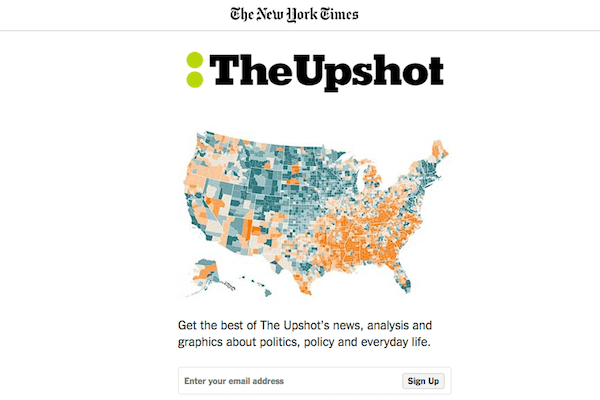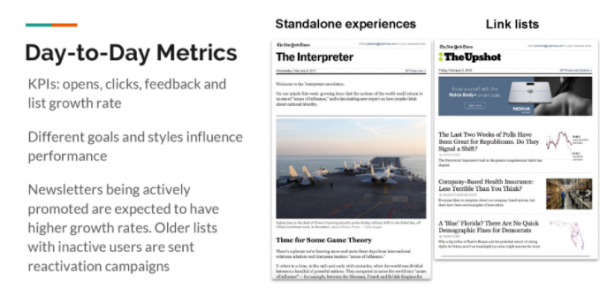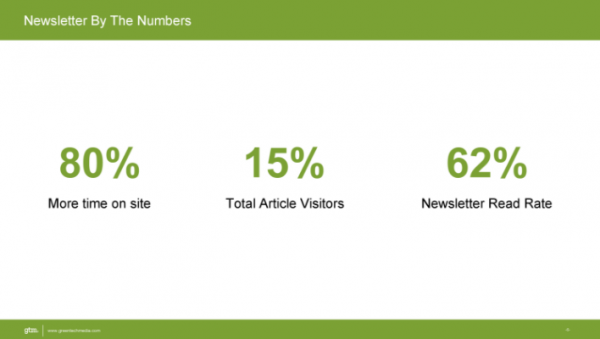3 stats that prove just how valuable newsletters are

Opening a newsletter, even if it’s not personalized, is inherently personal; newsletters arrive at “my” email address and speak to “my” interests (that is, the good ones do). The curated experiences of newsletters can make them feel like they’re just for you.
Not only do newsletters help brands forge direct connections with readers, but they let your readers build a personal rapport with your voice and values.
As a result, newsletter readers are more avid consumers of content, constituting valuable direct site traffic that the duopoly can’t touch, no matter how often algorithms change. “The value of reader relationships for digital publishers has never been higher,” Jason Alcorn, Metrics Editor at MediaShift, said.
The New York Times and Greentech Media joined MediaShift and Parse.ly to talk about how they create engaging newsletters. Here are three stats from the conversation that prove the value in forging those personal connections.
1.) The New York Times newsletter readers consume twice as much content as those who don’t get newsletters, and they’re twice as likely to become paid subscribers.
The New York Times has 14 million subscriptions to 50+ newsletters. Their newsletter mission is to “build meaningful relationships with readers by delivering our original, world-renowned journalism and product experiences straight to their inbox.”
“Every newsletter has a very different goal, whether it’s driving eyeballs back to the site, or serving as a testing ground for a new product, or serving as a special incentive to a paid subscription,” said Lindsay Goddard, Email Product Manager at The New York Times.

Ultimately, they strive to build experiences that are habit-forming, which in turn prime readers to convert to subscribers. “Doing these in-depth analyses really allowed us to see the value in a newsletter, and how they’re such useful habituation vehicles to becoming a paid subscriber,” Goddard said. Her team monitors the number of paid subscribers per newsletter list and growth over time.
Building successful “habituation vehicles” requires continual testing. Goddard’s team runs A/B tests to find the best levels of engagement for subject line treatments, newsletter length, number of stories ranked, use of collection headers, grouped content, different render styles, and deployment time of day. Goddard’s team also values feedback from readers comes in the form of surveys or readers writing back to their feedback email.
2.) Newsletter readers spend 80% more time on the site.
The value of newsletter audiences remains strong whether you have a whole team to manage it or just one person. Greentech Media’s audience consists of 1m monthly article views, 45k newsletter subscribers, and 400k monthly unique visitors. Newsletter subscribers represent 15% of total article visitors, even though they only make up 4% of Greentech Media’s monthly uniques, and they spend more time on site.

Email drives the most traffic for Greentech Media, so their daily newsletter design highlights headlines and features a mix of editorial content, native content, and sponsored content. “We send a lot of email. I look at that as a double edged sword,” said Brady Pierce, Senior Manager of Digital Marketing at Greentech Media. “It gives us ample opportunity to test things, try new templates—but also, we’re constantly on the edge of annoying our newsletter subscribers.”
For instance, Pierce wondered whether readers actually responded to images. He ran a test to see how design tied into newsletter traffic goals. As it turns out, images earned fewer than 1% of clicks when Greentech Media tested them in newsletters.
“We used to have images in our newsletter,” Pierce said. “People weren’t clicking them so we decided to get rid of them…. What happened is people liked looking at the pictures. They didn’t like clicking on them.”
3.) 24% of traffic to sites in Parse.ly’s network is direct, compared to 21% from search and 12% from social
Especially in light of the News Feed changes Facebook announced early this year, brands are wise to diversify referral traffic sources instead of putting all their eggs in one basket.
However, diversifying referral traffic sources goes beyond incorporating a multitude of platforms into your distribution strategy. It also means taking a look at traffic sources outside of the search and social categories.
Search and social are “just external referrers,” Clare Carr, VP of Marketing at Parse.ly, pointed out. “You still have these huge sources of audience that come in through other places….Search and social represent about 30% or so, but internal, other, and direct are still a huge portion.”
Internal traffic originates from somewhere else on your site, such as recommended content, infinite scroll, or someone clicking from one page to the next. Direct traffic is unidentifiable, which typically means email or a text message.
“Direct is where newsletters typically live,” Carr said. “That’s bigger than the search or social currently, so it’s something that you do want to care a lot about.”
If direct traffic is unidentifiable, how can you measure it? Tagging. Adding UTM parameters to links in your newsletter can help you analyze audience segments, calls to action, and send cadences. Not only that, but tagging can help you better understand what your readers are doing after they click.
The value of real attention
“Creating and capturing real attention is really what news and journalism sites need to be thinking about,” Carr said. And what better indicator of real, genuine interest than a newsletter reader who opts into becoming a subscriber, or who spends more time on your site than an average reader?
Direct traffic through newsletters offers the potential for connecting with readers on a personal level, delivering content that’s worth their attention, and then keep them coming back.